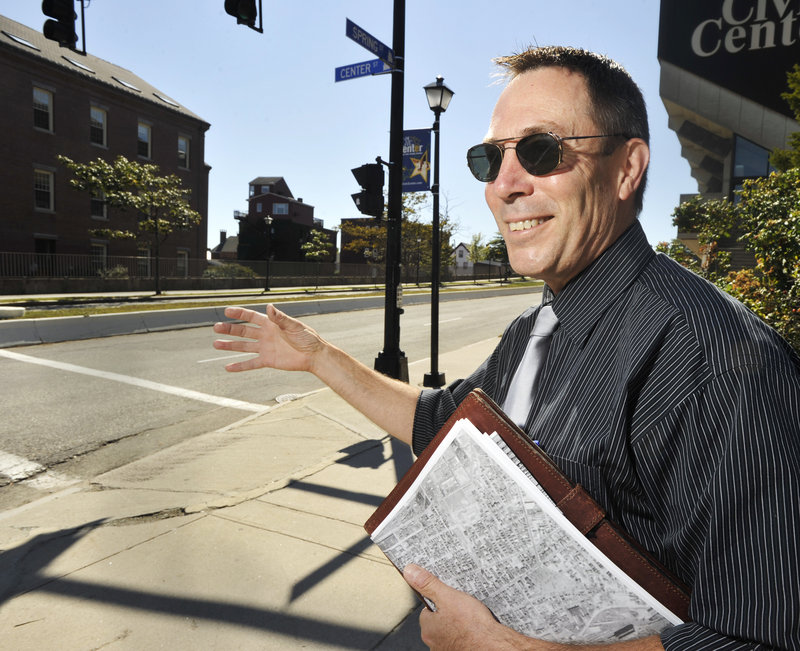PORTLAND — To Mark Johnson, much of Spring Street is a four-lane divided highway to nowhere.
Johnson sees a street largely out of scale with the surrounding environment, a barrier between the upper and lower portions of the city and an uninviting place for pedestrians. And then there are the Jersey barriers, which Johnson says have no place in a self-respecting urban setting.
To imagine what else Spring Street could be, the Portland Society of Architects is inviting its members to brainstorm design ideas today to share with the city.
Johnson, a member of the society’s advocacy committee and a landscape architect at SMRT Inc., describes today’s session as a “what-if” event. It will be held from 4:30 to 8:30 p.m. at the Cumberland County Civic Center meeting room.
Some of the impetus for the gathering actually stems from proposed renovations to the civic center. County voters will decide Nov. 8 on a $33 million bond referendum. Paul Stevens, a partner at SMRT Inc. and president of the society, is the architect for the project.
Once a two-lane street with its eastern end at Center Street, Spring Street in its current form is the product of a 1970s urban renewal project that had envisioned a system of ring roads around the city center.
The street is now dominated by the civic center and the Holiday Inn by the Bay. Office developments, parking areas and glimpses of smaller-scale older buildings are part of the view.
“You’ve got this nice, fine-grained urban area all around,” Stevens said. “Wouldn’t it be nice to have more of what makes Portland Portland?”
Ring-road systems were seen as a way to help the inner city survive as the population – and commercial activity – moved to the suburbs.
Franklin Street Arterial was the first part of the ring to be built. High and State streets were turned into one-way roads. The Spring Street Arterial was supposed to connect the Franklin Street Arterial with State Street via Middle Street, but the plan met with opposition.
The four-lane section stopped two blocks short of State Street, at the edge of a new Spring Street Historic District.
Nonetheless, the section starting at Temple Street was cleared for the arterial. Victorian commercial buildings and a row of 19th century houses were demolished. Greater Portland Landmarks moved one residence in the path of the arterial, the Gothic House, to another spot on Spring Street.
Forty years after the arterial’s creation, the area remains a stark urban environment, said Earle Shettleworth Jr., director of the Maine Historic Preservation Commission. Shettleworth was among the founders of Greater Portland Landmarks, which sought the historic district designation that halted the arterial.
Shettleworth does see room for improvement.
“I’m convinced that if you get a group of Portland architects in a room together, they’re going to come up with some very creative ideas,” he said. ” I think it’s by no means too late to consider that. It’s always an open question: how the city can be reinvented and improved?”
Staff Writer Ann S. Kim can be contacted at 791-6383 or at: akim@pressherald.com
View Spring Street in a larger map
Send questions/comments to the editors.



Success. Please wait for the page to reload. If the page does not reload within 5 seconds, please refresh the page.
Enter your email and password to access comments.
Hi, to comment on stories you must . This profile is in addition to your subscription and website login.
Already have a commenting profile? .
Invalid username/password.
Please check your email to confirm and complete your registration.
Only subscribers are eligible to post comments. Please subscribe or login first for digital access. Here’s why.
Use the form below to reset your password. When you've submitted your account email, we will send an email with a reset code.